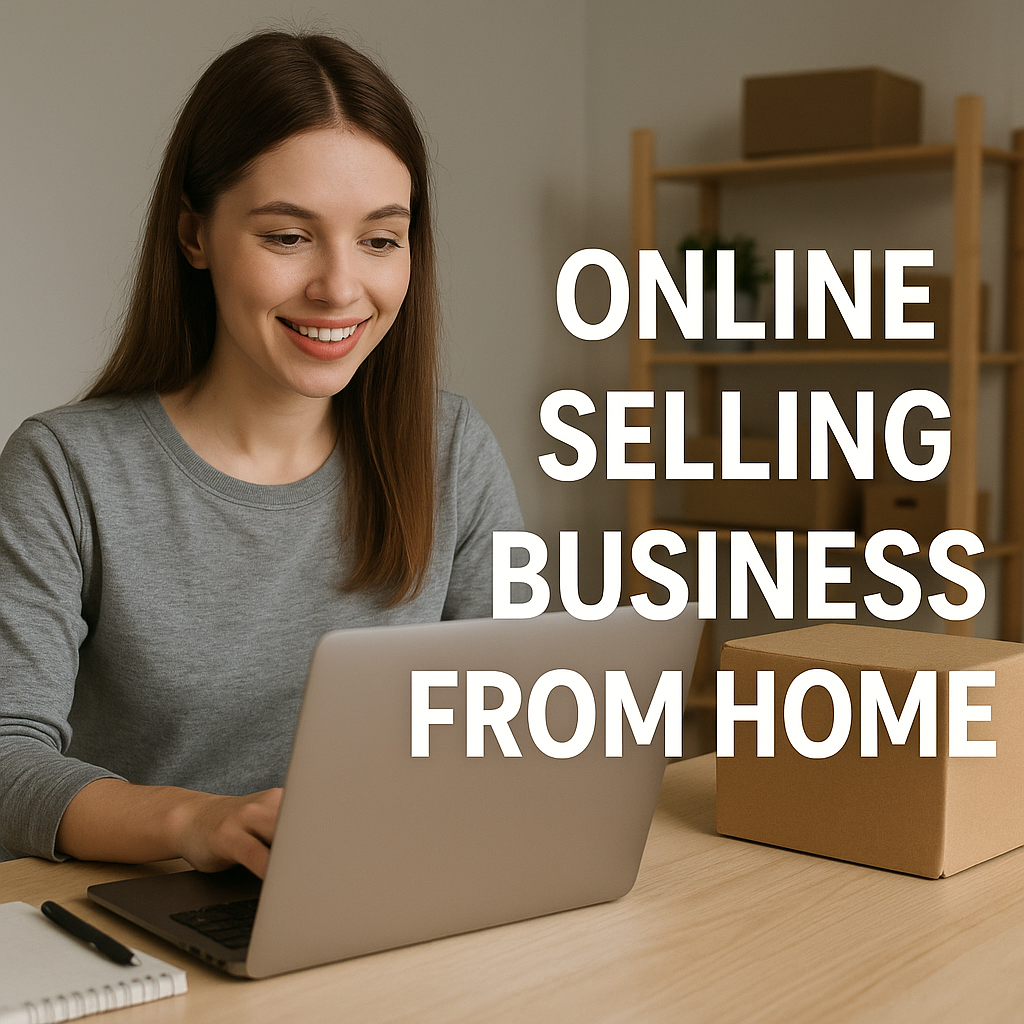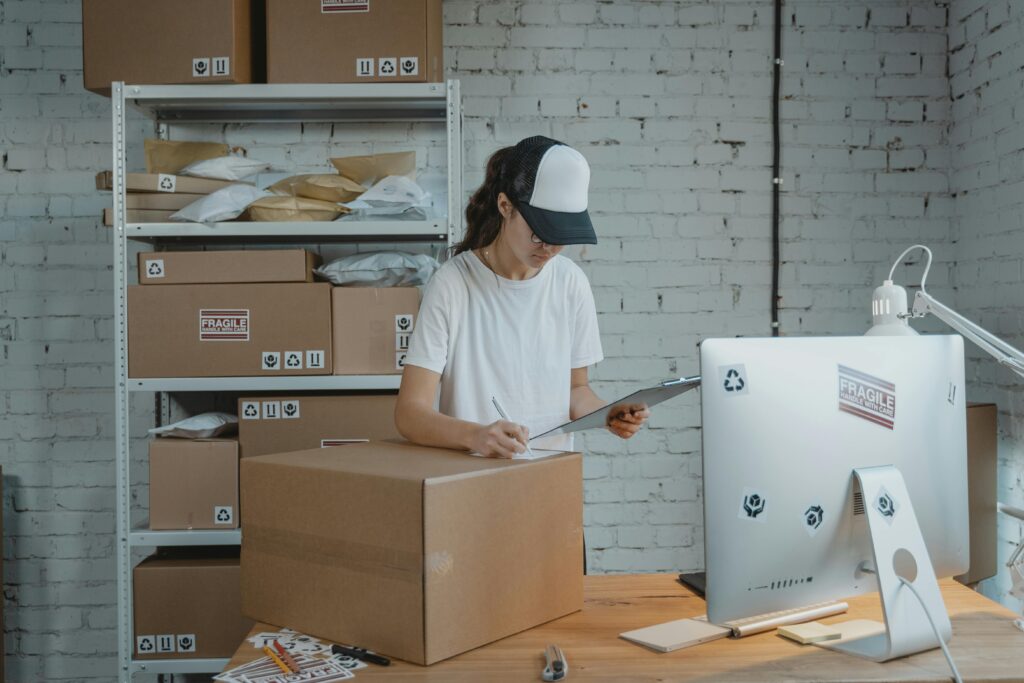Introduction: Online selling journey from home
First of all, congratulations on taking the first step toward building your own online selling business from home. This simple decision reflects ambition, independence, and the desire to create a future on your own terms through a home-based business.
Before diving into the technical steps to start an online business, it’s important to visualize what kind of online product selling venture you truly want to launch. Your idea should connect with your passion, solve a real problem, and offer value that stands out in the market. Think deeply—what drives you? Who do you want to serve? And what kind of change do you want to bring with your products?
Rushing into things like branding and websites may feel tempting, but the real strength of any successful online business from home lies in its foundation—your purpose, research, and clarity. With the right groundwork, your online selling journey will not just start—it will thrive.

So now that you’re ready to turn that idea into a real opportunity, it’s time to begin where all successful businesses do.
Here are 12 steps to start your online selling business.
Step 1: Identifying your profitable niche
“Before starting online selling, it’s important to decide what you want to sell. Choosing the right niche is the base of a successful online business. A niche isn’t just a product category – it’s a specific segment of the market that has demand but isn’t oversaturated..”

How to Identify a Profitable Niche for Your Online Selling Business from Home
Start with what you know or love
“You can use platforms like Google Trends, Amazon Best Sellers, or Meesho Categories to see what people are buying these days. Try to pick products that have steady or increasing demand.”
Analyse the competition
“A profitable niche should always have demand, but not too much competition. Browse marketplaces like Flipkart, Amazon, or local Facebook groups to see how many sellers are already offering what you have in mind. If your products or services face high competition, don’t lose hope—just focus on maintaining quality. In today’s market, all kinds of buyers exist, and most customers are looking for quality above all.”
Check the profit margins
Choose a niche where you can make a good profit. For example, ethnic apparel bought from wholesalers and sold via Instagram or marketplaces often offer good margins. Always calculate your costs—including platform fees and shipping—before finalising.

Test small and Scale Fast
One of the most common mistakes new sellers make in an online selling business from home is investing their entire budget into inventory right away. This approach can be risky and unsustainable. Instead, begin by allocating just 10% of your available funds to test a small batch of products.
Monitor what sells, gather genuine customer feedback, and study consumer behavior. Use this data to evaluate product performance and identify what truly works. Once you confirm steady demand and market fit, you can gradually scale your investment in the best-performing items.
Keep in mind: this business is highly unpredictable, and market trends can fluctuate frequently. That’s why careful observation is crucial. Avoid overconfidence, and let your decisions be guided by real results, not assumptions.
By following this low-risk, analytical approach, you increase your chances of building a sustainable and profitable online selling business from home, while minimizing unnecessary losses and adapting smartly to market changes.
Some of the high-potential sectors for online sellers to start their online selling business
- Women’s fashion (kurtis, gowns, sarees)
- Home decor and kitchen utensils
- Baby products
- Mobile accessories
- Natural skincare or organic items

Step 2: Setting Up a Dedicated Workspace for Your Online Selling Business from Home
Creating a dedicated workspace at home is essential for maintaining productivity and professionalism, especially when you’re building an online selling business from home. A well-planned setup helps you stay organized, focused, and ready for day-to-day operations like managing inventory, processing orders, and handling customer communication.
Start by selecting a quiet corner with good lighting and minimal distractions. Your home office should include the essentials:
- A reliable computer or laptop
- Stable internet connection
- A notebook or planner for tracking tasks
- Basic stationery for packaging and order management
- Adequate storage space for your products
- Equally important is the accessibility of your workspace.
Since courier pickup agents will frequently visit to collect parcels and handle return orders, your location should ideally be road-facing or easily reachable. This ensures smooth and timely logistics, which is a key factor in maintaining high seller ratings on platforms like Amazon, Flipkart, and Meesho.
A clean, organized, and fully functional home office not only increases your operational efficiency but also reinforces the mindset that you’re running a real business—even if it’s from home. This professional approach is vital for long-term growth in the online selling business from home model.

Step 3: Choosing the Right E-commerce Platform
Selecting the right platform to sell your products is a key step in building your online business. Start by identifying where your target customers are most active. Some popular options include:
Online Sales Channels: Amazon, Flipkart, Meesho
Start Your Online Selling Business from Home with Trusted Marketplaces
Starting an online selling business from home has never been easier, especially with platforms like Amazon, Flipkart, and Meesho. These eCommerce marketplaces offer a ready-made infrastructure that’s perfect for beginners. They provide access to a large customer base, manage heavy traffic, and help build trust through their established brand reputations. Most importantly, they offer reliable logistics and payment support—allowing you to focus on what truly matters: product quality, competitive pricing, and on-time delivery.
Among these platforms, Meesho is particularly known for generating high order volumes, especially for fashion and lifestyle products. However, sellers should be aware of potential issues such as fake or incorrect return claims. To maintain profitability, it's crucial not to compromise too much on margins in pursuit of more orders.
Instead, prioritize reliable and high-quality products that solve real customer needs. This approach ensures long-term success and helps build a sustainable online selling business from home.
Whether you're just starting out or looking to grow your home-based business, these platforms can serve as powerful tools—if used wisely.
Shopify or WooCommerce
Ideal if you want to create your own branded store. These give you full control over your website, design, and customer data—but require more effort in marketing and order fulfillment. Especially with WooCommerce, you’ll need a proper team to handle technical setup, maintenance, product uploads, customer support, and promotions. Without the right support, managing everything alone can quickly become overwhelming and leave you feeling stuck or hopeless.

Social Media Platforms (Instagram, Facebook, WhatsApp):
Ideal if you want to create your own branded store. These give you full control over your website, design, and customer data—but require more effort in marketing and order fulfillment. Especially with WooCommerce, you’ll need a proper team to handle technical setup, maintenance, product uploads, customer support, and promotions. Without the right support, managing everything alone can quickly become overwhelming and leave you feeling stuck or hopeless.
Step 4: Sourcing and Managing Inventory
Finding Reliable Suppliers and Manufacturers
Building strong relationships with trustworthy suppliers is crucial for your online selling business from home success. Begin by researching potential partners through industry trade shows, online directories like Alibaba, ThomasNet, IndiaMART, and ExporterIndia, as well as e-commerce-focused social media groups. Before committing, always request product samples to evaluate quality and communicate your expectations clearly. It’s wise to work with multiple suppliers to avoid disruptions if one faces issues, ensuring smooth and consistent operations.
Dropshipping vs Holding Inventory
Each inventory model offers distinct advantages:
Dropshipping
- Minimal upfront investment: Since you don’t need to buy products in bulk or hold inventory, the initial costs are much lower compared to traditional retail. You only purchase items after a customer places an order.
- No storage space required: You don’t need a warehouse or extra room at home for stock. The supplier handles storage and shipping, freeing you from logistics headaches.
- Reduced risk of unsold inventory: Because products are only bought after orders come in, you avoid the risk of being stuck with unsold or outdated stock.
- Ability to offer a broader product range: Without inventory limitations, you can list many products across different categories, giving customers more options and increasing your chances of sales.
Holding Inventory
- Better profit margins: Buying products in bulk often means lower costs per unit, which can lead to higher profits when you sell them.
- Greater control over quality: Having the products on hand allows you to inspect and ensure quality before shipping to customers, reducing returns and complaints.
- Faster shipping times: Since items are ready to ship from your location, you can offer quicker delivery, improving customer satisfaction.
- Opportunity for custom packaging: You can add branded packaging or personalized touches, enhancing your brand image and customer experience.
- Independence from supplier stock levels: You’re not dependent on suppliers’ availability, so you won’t face delays or cancellations due to stock shortages.
Many successful home businesses start with dropshipping to test products before transitioning to holding inventory for best-sellers.
Quality Control Measures
Even when working from home, it’s important to implement strong quality checks to maintain customer satisfaction.
- Inspect incoming inventory samples thoroughly: Check products carefully as soon as they arrive to catch any defects early.
- Document quality standards for each product: Define clear criteria for what qualifies as acceptable quality, so everyone involved knows the expectations.
- Photograph items before shipping: Take pictures of products before sending them out to have proof of condition in case of disputes.
- Collect and analyze customer feedback: Regularly review reviews and complaints to identify recurring quality issues.
- Create a returns process that identifies quality problems: Use returns data to pinpoint defects and improve supplier communication or product selection.
For dropshipped products, order samples periodically to ensure your supplier consistently maintains quality standards.
Inventory Tracking System
Managing your inventory efficiently is key to avoiding stock outs that disappoint customers or excess stock that ties up capital. Here are essential practices to keep your inventory under control:
- Use inventory management software such as Sortly, Zoho Inventory, or Shopify’s built-in tools to monitor stock levels in real time.
- Set automatic reorder points based on how fast products sell to replenish stock before it runs out.
- Conduct regular physical inventory counts—weekly for small businesses—to verify accuracy.
- Track important metrics like sell-through rate and inventory turnover to understand product performance.
- Implement barcode systems to speed up stock processing and reduce errors.
Step 5: Smart Storage Ideas for Online Selling Business from Home
Making the most of your available space is essential when running an online business from home. Staying organized helps prevent product damage and streamlines order fulfillment. Consider these storage tips:
- Dedicate specific areas solely for inventory storage to keep things orderly.
- Invest in shelving units that utilize vertical space, freeing up floor area.
- Label all items clearly with SKU numbers for quick identification.
- Consider climate control for products sensitive to temperature or humidity.
- Use creative storage like under-bed containers, closet organizers, or garage shelving.
- As your business grows, explore options like micro-warehousing or nearby self-storage units for extra space.
With the right inventory management and storage solutions, you’ll be well-prepared to focus on expanding your customer base and scaling your business efficiently.
Step 6: Build a Strong Brand Identity for Your Online Selling Business from home
Your brand is how people see and remember your business. It’s more than just a logo—it’s the full image and message you send to your customers. A strong brand builds trust and helps you stand out. Here’s how to create it:
- Know your purpose and values: Be clear about what your business is about and what it believes in. This helps you connect with the right audience.
- Pick a good name and logo: Choose a name that’s easy to remember and a logo that matches your business style.
- Keep your style the same everywhere: Use the same colors, fonts, and design on your website, social media, and packaging so people can recognize your brand easily.
- Decide how your brand talks: Whether it’s friendly, helpful, fun, or serious—use the same tone in all your messages.
- Share your story: Talk about how and why you started. People love real stories, and it makes your brand feel more personal.
- Use your brand on everything: Put your brand name, logo, and message on all your products, packages, and online platforms.
When your brand looks and feels clear and trustworthy, people are more likely to buy from you and remember you.
Step :7 Effective Pricing Strategies to Maximize Profit
Pricing Strategies for Maximum Profit
Setting the right price is very important in Your Online Selling Business from Home. It affects your sales, profit, and how customers see your products. Here are smart ways to price your products:
- Know your costs: First, calculate how much each product costs you—including material, packaging, shipping, and marketplace fees. Never sell below your cost.
- Add your profit margin: Profit is the backbone of any business. It’s what keeps your business running and growing. So, decide how much profit you want to make on each sale after covering all your costs—like product cost, packaging, delivery, platform fees, etc.
A healthy profit margin does two important things:
- It supports steady growth, helping you reinvest in stock, tools, or marketing.
- It makes your business stable and scalable, so you can handle more orders without falling into loss.
Avoid setting very low prices just to attract customers. Instead, offer real value, maintain quality, and price smartly. This way, you build a strong and profitable business that can grow over time.
- Check the market:
- Before finalizing your price, research how much other sellers are charging for similar products. This gives you a clear idea of the price range customers are used to.
- Avoid setting very low prices just to get quick orders. While it might bring some sales in the beginning, it can hurt your profit in the long run and make it harder to raise prices later. Instead, focus on offering value—good quality, service, and trust—at a fair price.
- Smart pricing keeps you competitive without compromising your profit.
- Try psychological pricing: Prices like ₹299 or ₹499 look more attractive than ₹300 or ₹500. Small changes can boost sales.
- Offer bundle deals or discounts: Selling products in a combo can increase order value. But make sure you’re still making a profit.
- Adjust prices smartly: If a product sells well, you can slowly increase the price. If it’s not moving, try small discounts or highlight it better.
A good pricing strategy gives you profits, keeps your customers happy, and helps your business grow steadily.
Step 8: Streamlining Order Fulfillment
Order fulfillment is the process of receiving, packing, and shipping customer orders. Doing this smoothly and on time builds trust and keeps customers coming back. Here’s how to streamline the process and avoid delays:
🔹 How to Make Order Fulfillment Efficient:
- Stay organized: Arrange your inventory neatly and label items with SKUs or codes to find them easily.
- Use order management tools: Platforms like Shopify, WooCommerce, Unicommerce, or Zoho Inventory help track orders, update stock, and manage dispatches from one dashboard.
- Fix a daily dispatch routine: Set aside time daily (e.g., morning or evening) for packaging and order handover.
- Pre-plan packaging: Keep boxes, tapes, polybags, invoices, and thank-you cards ready to reduce last-minute stress.
- Choose reliable courier services: Use services like Delhivery, Shiprocket, India Post, or Amazon Easy Ship for consistent delivery.
- Handle returns smoothly: Prepare a simple, clear return policy. Make sure returned items are inspected and restocked properly.
Beginner’s Fulfillment Checklist
- Inventory is sorted and labeled
- Daily time slot fixed for packing
- Packaging material stocked
- Order alerts turned on (email/SMS/app)
- Courier service accounts created
- Return process written and shared with buyers
Step 9: Navigating Legal and Financial Requirements for Your Online Selling Business from Home
Starting an online selling business from home is exciting, but it’s important to keep everything legal and organized from the start. Here’s what you need to know:
Basic Legal Requirements
- Register Your Business:
Choose a business type—Sole Proprietorship, Partnership, or Private Limited Company—based on your plans. Most home-based sellers start as sole proprietors for simplicity. - Apply for a GST Number:
To sell products online, GST registration is mandatory. You must get a GSTIN (Goods and Services Tax Identification Number) if your annual turnover exceeds ₹20 lakhs, or even earlier if you sell on platforms like Amazon, Flipkart, or Meesho. - PAN and Bank Account:
Keep your business finances separate by using a dedicated PAN card and opening a current bank account for all business transactions. - Import-Export Code (IEC):
If you plan to sell internationally, apply for an IEC through the Directorate General of Foreign Trade (DGFT).
Financial Setup and Tax Compliance
- Track Income and Expenses:
Use tools like Tally, Zoho Books, Vyapar, or even Excel to manage your sales, returns, packaging, and marketing costs. - Hire a Chartered Accountant (CA):
A CA can help with GST filings, tax returns, and keeping your books audit-ready. - Issue Proper Invoices:
Always generate GST-compliant invoices that clearly show product details and tax breakdowns. - Stay Updated:
Tax rules can change often, so stay informed or consult your CA regularly to avoid penalties.
Pro Tip:
Keeping your legal and financial work organized protects your business and makes it easier to get loans, subsidies, or investments when you need them.
Step 10: Scaling Your Online Selling Business from Home for Long-Term Growth
Starting small at home is just the beginning. To grow your online business and reach more customers, you need smart strategies for scaling. Here’s how you can take your business to the next level:
Focus on Best-Selling Products
Identify your top sellers by tracking sales and customer feedback. Invest more in these products—expand varieties, improve quality, and boost marketing around them.
Automate and Outsource
Use tools to automate tasks like inventory management, order processing, and marketing. As orders grow, consider outsourcing packing and shipping to third-party logistics (3PL) services so you can focus on sales and product development.
Expand Your Sales Channels
Don’t rely on just one platform. Sell on multiple marketplaces like Amazon, Flipkart, and Meesho, and build your own branded website. Also, use social media platforms to reach niche audiences directly.
Build Your Brand
Create a strong brand identity with consistent logos, packaging, and messaging. Happy customers become repeat buyers and brand ambassadors who spread the word.
Invest in Marketing
Use paid ads, influencer partnerships, email marketing, and content marketing to attract and engage customers. Track which campaigns bring the best returns and focus your budget there.
Manage Finances Wisely
Keep a close eye on cash flow, profit margins, and expenses. Reinvest profits smartly into inventory, marketing, and tools that support growth.
Pro Tip: Scaling takes time and effort, but with a clear plan and steady actions, your home business can grow into a thriving venture.
Conclusion: Building a Successful Online Selling Business from Home
Starting an online selling business from home is more accessible today than ever before. With the right niche, smart strategies, and consistent effort, you can transform your ideas into a profitable venture without massive upfront investment or complex setups. Remember, success comes from understanding your market, delivering quality products, building a trustworthy brand, and maintaining excellent customer service.
While challenges will arise, staying organized, adapting to feedback, and continuously learning will help you overcome them. Whether you choose to sell on established marketplaces, social media, or your own website, the key is to start small, test your ideas, and scale thoughtfully.
Your journey from a kitchen-table entrepreneur to a thriving online seller begins with a single step—take it today, and build the business you’ve always imagined.

